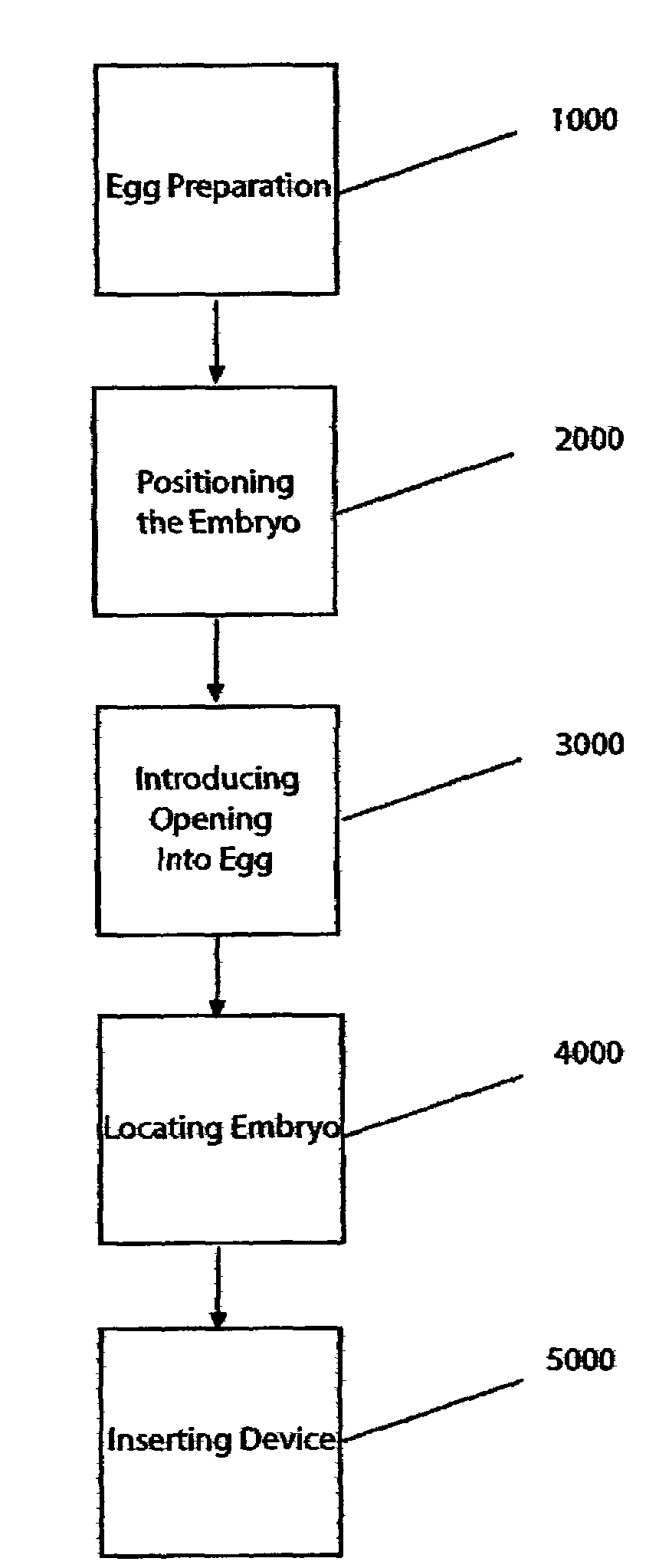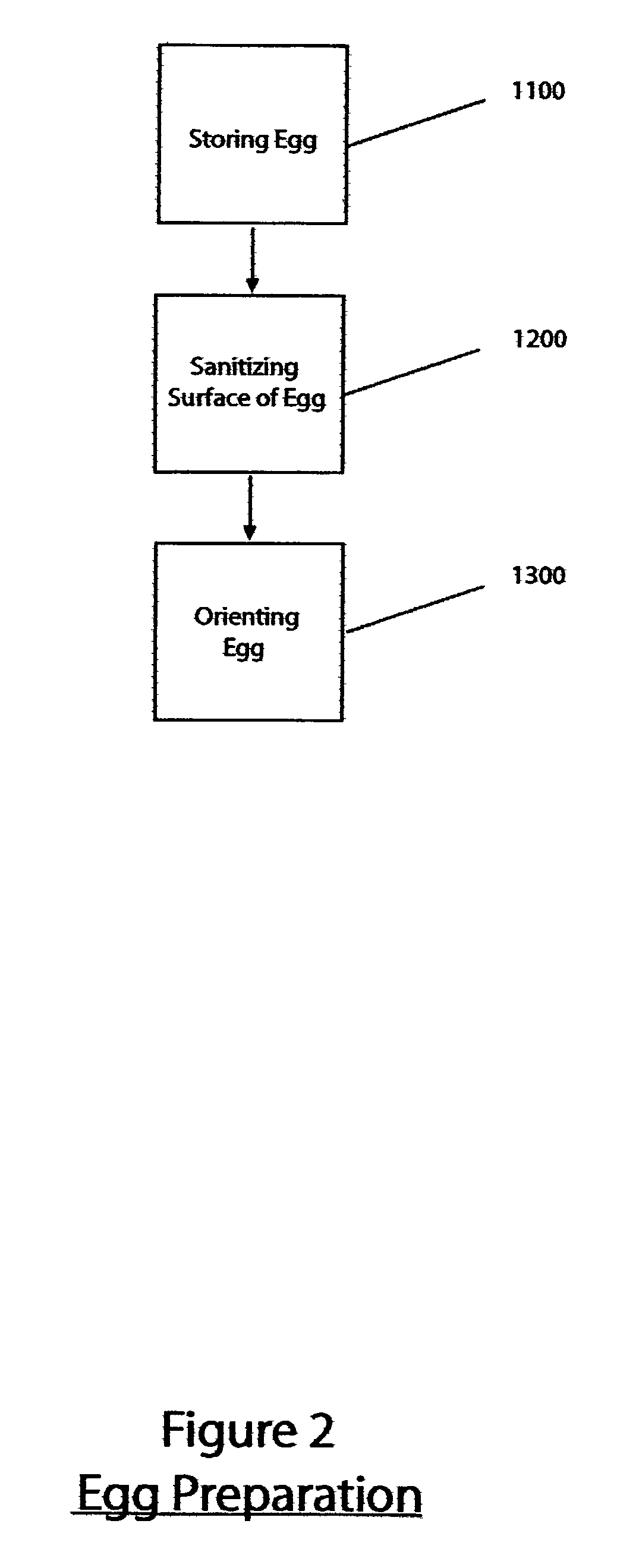Methods for injecting avian eggs
- Summary
- Abstract
- Description
- Claims
- Application Information
AI Technical Summary
Benefits of technology
Problems solved by technology
Method used
Image
Examples
example 1
[0118]The following is an exemplary method used to inject fluid or cells into recipient chicken blastoderms in ovo through the blunt end of the egg:[0119]1. Surface sterilize the entire egg surface of Day E 0 eggs by wiping with 100% ethanol.[0120]2. Candle the egg to locate the air cell. The position of the air cell is marked on the shell with a pencil.[0121]3. A window (small opening) is made at the blunt end of the egg (in center of air cell) by dremeling away the shell. Care is taken to keep the outer shell membrane intact.
All of the following steps are preferably carried out in a laminar hood or in a clean room:[0122]4. The blunt end of the egg, where the outer shell membrane is exposed through the window in the shell, and the surrounding area are again surface sterilized using 70% ethanol.[0123]5. The outer shell membrane is carefully removed with forceps and scalpel (#11 blade; Personna Medical) taking care not to leave any jagged edges to the membrane.[0124]6. The blastoderm...
example 2
[0129]A series of experiments was carried out to evaluate the use of manual injection as described in Example 1 to inject either fluid or cells into the subgerminal cavity of recipient chicken blastoderms (approximately Stage X) in ovo. Donor cells were also from Stage X chicken blastoderms. In some cases, the recipient embryo was compromised prior to injection. In early experiments, a small droplet (a few μl) of an albumen solution was deposited on the inner shell membrane above the blastoderm and injection was performed by piercing the membrane through the albumen droplet. In later experiments, this step was omitted. Eggs were either not stored or stored from 4 to 8 days prior to treatment.
[0130]Hatch rates in control and manipulated eggs were determined. The rate of successful chimera production was also evaluated. The results are shown below in Table 1.
[0131]
TABLE 1Percent Chimera ObtainedRecipientCompromiseDonorNo. ofNo. ofHatchability of ControlBased onBased onEggRecipientEggE...
example 3
[0132]Certain methods of physical compromise of the embryo, such as ultraviolet (UV)-irradiation or laser ablation, may be administered through a window in the egg shell and shell membranes. We have developed a method to create a window in the side of the egg, seal it, and incubate the egg under standard conditions (99 F, rocking), that allows a very high percentage (>90%) of embryos to develop normally at two days (FIG. 7). This method may be used to evaluate the effects of compromise and chimera production at two days of embryonic development. Further, this method may be used to inject into the side of the egg.
[0133]Briefly, the eggs were treated as follows:[0134]1. Eggs were stored at 60 F, 75% humidity for 0-7 days, on their long axis, to steer the blastoderm towards the center of the side of the egg.[0135]2. The position facing upwards was marked with a sharpie pen.[0136]3. Following storage, a 7-mm hole was drilled at the side of the egg, at the location of the pen mark.[0137]...
PUM
| Property | Measurement | Unit |
|---|---|---|
| Fraction | aaaaa | aaaaa |
| Fraction | aaaaa | aaaaa |
| Fraction | aaaaa | aaaaa |
Abstract
Description
Claims
Application Information
 Login to View More
Login to View More - R&D
- Intellectual Property
- Life Sciences
- Materials
- Tech Scout
- Unparalleled Data Quality
- Higher Quality Content
- 60% Fewer Hallucinations
Browse by: Latest US Patents, China's latest patents, Technical Efficacy Thesaurus, Application Domain, Technology Topic, Popular Technical Reports.
© 2025 PatSnap. All rights reserved.Legal|Privacy policy|Modern Slavery Act Transparency Statement|Sitemap|About US| Contact US: help@patsnap.com



